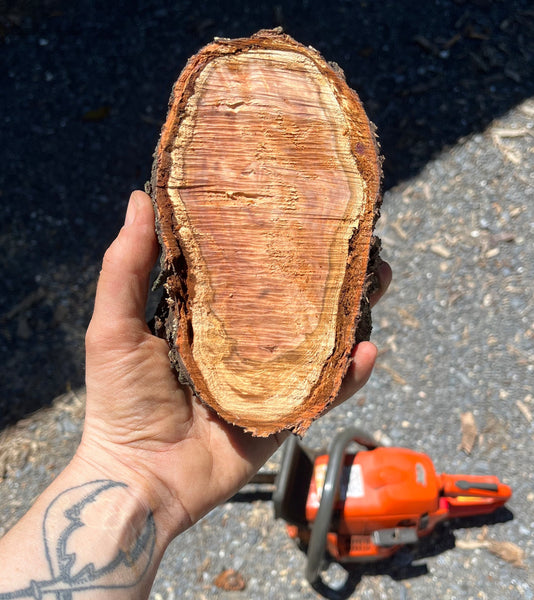What is Burl

A burl is a strange-looking collection of tree cells, which are called callus tissue. A burl is made up of a tree’s bud tissue that has not sprouted into foliage or grown into a twig. It has a woody or barked surface. As a burl grows, it incorporates the tree’s undeveloped buds that surround it and folds them into its expanding form. Because these cells can grow faster than regular tree cells and can grow during all seasons, burls expand at their own rate into unpredictable sizes and appearances. In human terms, it can be compared to a fast-growing but non-malignant tumor.
If you cut open a burl, you’ll find wood inside. As with sawn lumber, cutting in different directions across a burl will expose different wood grain patterns. Unlike typical tree lumber, the patterning or figuring of a burl’s wood is more complex and entirely unpredictable.
Because burls are wound response tissue, they grow where and how they “need” to in order to protect a tree. As they grow, their un-sprouted bud tissue is folded, rolled, or compressed, creating unique growth patterns within the burl. Some may even contain mineral deposits from flooded soil or air pockets and interior bark ridges from eroded areas of wood that have been incorporated into the burl.
Source: https://organicplantcarellc.com/what-is-a-burl/

I harvest burl myself. I source my wood from dead trees from my family farm. This is where my woodworking skills come in handy with my jewelry pieces. From time to time I am commissioned for chainsaw carvings. As I am carving sculpture, I set favorable scraps aside to incorporate in my jewelry. The wood in my jewelry is sanded with high grit sandpaper to bring out the most details of the wood grain and finished with a simple layer of Tung Oil.



December 6 – 7, 2025
Craft Westport
CraftWestport, presented by the Women’s League of Westport, is a thoughtfully curated shopping event featuring 175 modern American artists and makers!
Spend the day with family and friends shopping for one-of-a-kind and uncommon items such as original fashions, accessories and jewelry; functional and sculptural works in ceramics, glass, metal, fiber, wood and mixed media; and fine art painting, printmaking, drawing and photography and more!

December 5th-7th, 2025
Baltimore Jewelry Center Holiday Sale
Our annual Holiday Sale is coming up! Join us December 5th - 7th and shop handmade works from BJC community members.
Find the perfect piece for a loved one, or to keep for yourself! ;)
Friday, December 5 — 5:00-8:00pm
Saturday, December 6 — 12:00-6:00pm
Sunday, December 7 — 12:00-6:00pm

Saturday, December 13⋅12:00 – 5:00pm
Pyramid Atlantic Winter Solstice Holiday Market
Good Company is gathering makers whose craft honors the changing of the seasons and harks back to traditions that celebrate the annual cycles—from Saturnalia feasts to solstice fires to the quiet work of winter preparation. This free, family-friendly community gathering will invite 15-20 artists and artisans whose work aligns with our Winter Solstice theme.
- When: Saturday, December 13, 12–5 PM
- Where: Pyramid Atlantic Art Center, 4318 Gallatin Street, Hyattsville, MD

December 14th, 12-5pm
Greater Goods Market
Join us at R.House in Remington for the Greater Goods Holiday Market, featuring 90 incredibly talented Baltimore artists and small businesses.

December 20th, 1-6pm
Winter Solstice Market
Come celebrate the longest night of the year at the Winter Solstice Market, filled with cozy vibes, festive treats, and unique gifts!
Welcome to the Winter Solstice Market! Join us at Peabody Heights Brewery for a festive event filled with local vendors, delicious food, and seasonal drinks. Get into the holiday spirit with unique gifts and crafts, all while supporting small businesses in the community. Don't miss out on this opportunity to shop, eat, and celebrate the winter season with us!

With Gratitude, Always
I wouldn’t be creating the artwork that brings me so much joy without your support—and for that, I am forever grateful. Every piece I make is not just a reflection of my vision, but a shared journey with the people who believe in the power of handmade craft and storytelling. Your encouragement allows me to keep exploring, experimenting, and evolving as an artist. Thank you for being part of this creative path.
